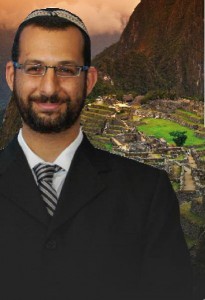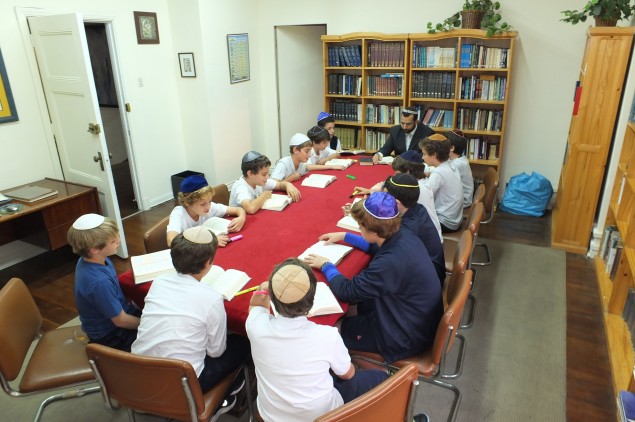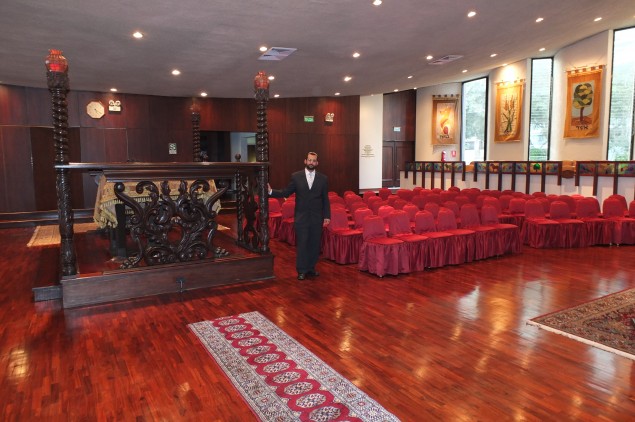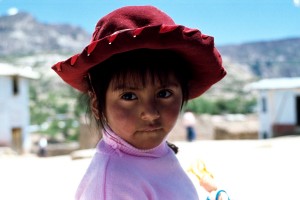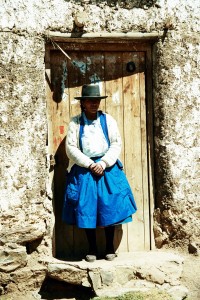A Conversation with Rabbi Itay Meushar of Peru
Editor Nechama Carmel speaks with thirty-seven-year-old Rabbi Itay Meushar from Ma’ale Adumim, Israel who has been leading the Ashkenazic community in Peru for the past three years and is seeking to make a dent in the country’s rampant assimilation problem.
Thirty-seven-year-old Rabbi Itay Meushar leads the Ashkenazic community in Peru. Courtesy of Rabbi Itay Meushar
Jewish Action: How did you come to be the rabbi of the Ashkenazic community in Lima, Peru, the biggest Jewish community in the country?
Rabbi Meushar: While I grew up in Ma’ale Adumim, Israel, I speak Spanish because my family lived in Uruguay for four years when I was a young child. In Israel, I attended Birkat Moshe in Ma’ale Adumim, where I obtained semichah. In 2009, Rabbi Ephraim Zik, who had served as the rabbi in Lima for ten years, called me and told me he was going back to Israel and was looking for someone to take over his position.
I thought to myself: I want to do outreach and bring Jews closer to Judaism. If the Ribbono shel Olam made me a Spanish speaker, it must be for a reason. What could I do with my abilities?
To her credit, my wife agreed to move. She didn’t speak Spanish, but now, baruch Hashem, she gives shiurim in Spanish.
Boys learning in the Bar Mitzvah program run by Rabbi Meushar.
Courtesy of Rabbi Meushar
I am associated with the Religious Zionist Torah MiTzion movement, which actually has a kollel in Lima. (The kollel currently consists of two bachurim. We are looking to recruit more Spanish-speaking avreichim to join us.)
Peru is a major tourist attraction for Israelis—especially for those seeking adventure after serving in the military. Each year, the Chabad house in Cusco, the ancient capital of the Inca Empire, hosts a Pesach Seder for hundreds of Israelis.
Over the last fifteen years, the community has sought out rabbis from Eretz Yisrael—mostly Religious Zionist rabbis because the community in Lima is very Zionistic and believes strongly that the rabbi should serve as a bridge between the galut and Eretz Yisrael.
JA: Can you describe the Jewish community of Peru?
RM: Out of a general population of approximately 27 million people, there are fewer than 3,000 Jews. Most of them are concentrated in the capital city of Lima, a large city located along Peru’s coast. There are two Orthodox communities: the Ashkenazic community and the Sephardic community. (The majority of Jews are not observant, but they are traditional and associate with the Orthodox movement.) Our shul—Union Israelita del Peru—has 600 members. On Friday night, some 150 people show up to services. On Shabbat morning, around seventy people attend.
Rabbi Meushar has been leading the largest Orthodox community in Peru for the past three years. Courtesy of Rabbi Meushar.
Kosher in Peru
With its growing economy and increasing interest in exporting to the US and Europe, Peru is rapidly becoming a new center for OU-certified products.
“We are exploding in Peru and Chile,” says Rabbi Yitzchok Gutterman, OU rabbinic coordinator and regional director, South America. “And we’ve experienced significant growth throughout the entire continent.”
 Symbol of Kosher Peru. Courtesy of Rabbi Meushar.
Symbol of Kosher Peru. Courtesy of Rabbi Meushar.
OU Kosher already has a strong presence in South America with hundreds of OU-certified companies in countries such as Argentina, Brazil and Columbia. But with Peru’s rich land and natural resources, the country promises to be a leader in raw materials, food coloring, spices, flavorings and general fish and agricultural product exports.
“Currently, quinoa, a highly nutritious grain grown in Peru and other parts of South America, is becoming very popular among health-conscious kosher consumers,” says Rabbi Shoshan Ghoori, OU director of client relations in Latin America.
Rabbi Ghoori, who studied at the Kolel Avreichim de Chile and helped establish NCSY Chile, works closely with Sandro Monteblanco, a Peruvian businessman, to educate Peruvian companies as well as governmental agencies about the enormous benefits of going kosher. Some of the more prominent OU-certified companies in Peru are Alicorp, Peru’s largest processor of edible oils, and Montana, a major player in natural food colorants and flavors.
“Peru understands that kosher certification is critical to compete in today’s international market,” says Rabbi Ghoori.
Although Peru is a predominately Catholic country, there is not a lot of anti-Semitism. For the most part, there is respect for the Jews. Unfortunately, this is why there is a lot of assimilation and very high rates of intermarriage. But slowly the Jewish community is moving toward greater religious observance. We have our own local kosher certification; there is a kosher mini mart, a mikvah and a community school.
I work closely with the OU. [See sidebar.] Kosher meat is available from Israel, and my father, who lives in Israel and is a shochet, travels to Peru every three to four months to shecht animals for the kehillah. I am the local shochet for chickens.
My wife and I play many roles here. She is the “mikvah lady” and gives shiurim for women in the community. I supervise the local kosher certification, organize the daily minyanim, perform levayahs, prepare children for their Bar or Bat Mitzvah and run ongoing classes, shiurim and community events. We are a two-person team.
A Peruvian girl in the village of Coris. Photos: Jack Hazut/www.israelimage.net
JA: What are you doing to instill in young people a strong Jewish identity?
RM: There is a community school with 400 students attended by the Orthodox and Conservative communities (there is no Reform movement in Peru). The school educates about 80 to 90 percent of the Jewish children in the city. I send my own children—I have five (beli ayin hara)—to the community school, but they also get educated at home. I believe that even in cities such as New York, Yiddishkeit is learned in the home. You cannot downplay the significance of the home. Nevertheless, as the children get older, it becomes more difficult to provide them with a quality Jewish education. When my son becomes a bar mitzvah in January, we will send him to live with my parents so he can study in a yeshivah in Israel.
Reaching out to young people is an ongoing challenge. Many young Jews do not stay in Peru. Their parents send them to Israel or to the United States. Younger children in the community participate in our shul’s Bar and Bat Mitzvah program. The program is run like a youth group: we not only teach Torah and how to put on tefillin, we play soccer (a major sport in Peru), paintball and other sports and show the kids how Judaism can be fun. But we know that we need to do more. NCSY in Chile is highly successful; we want to bring it here as well.
JA: What is unique about your community?
RM: There is an unusually warm relationship between the rabbi and the community. I don’t believe you find this in larger Jewish communities. After Shabbat davening, there’s a kiddush with hot kugel and other Shabbat delicacies. Congregants stay to eat and then participate in a shiur where there’s much back-and-forth with lots of questions and answers. The community is very close-knit; we’re like one big family.
JA: Is the community growing stronger religiously?
RM: We realize that change cannot happen from today until tomorrow. Change is a slow, gradual process. But people tell me that compared to ten and twenty years ago, what they are seeing now is amazing.
Baruch Hashem, there are more and more people who want to learn Torah, who want to understand how Torah applies to the modern world. And more and more mitpallelim are coming to shul.
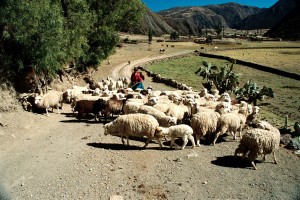 A shepherd tending to his flock in the village of Porto da Cruz.
A shepherd tending to his flock in the village of Porto da Cruz.
The History of Peru’s Jewish Community
The original Jewish settlers of Peru came from Spain in the sixteenth century to escape the Inquisition. Those who survived are believed to have assimilated and lost all connection to Judaism. The roots of the modern-day Jewish community in Peru date back to the arrival of
Ashkenazi Jews from Western and Central Europe, including England and Germany, in the mid-nineteenth century. Before World War I and in the inter-war periods, many more Ashkenazi Jews from Eastern Europe and Sephardim from the Ottoman Empire came to Peru. In 1970, the Jewish community reached its peak, with a population of nearly 5,200. However, it has slowly declined since then due to political and economic instability in the region.
Today, while the Jewish community in Peru has dwindled significantly, Jews are well represented in Peruvian life. There have even been Jewish prime ministers
There is even a small group of shomer Shabbat Jews. But I believe that every Jew who comes to shul in this kind of environment is a tzaddik. The connection with the shul is very important. For the Jews in Peru, it’s important to feel that they are part of something big; to feel connected to the rest of the Jewish world. It gives us strength.
JA: What is your biggest challenge right now?
RM: To maintain the community’s religious growth and to build upon it. There’s a thirst for learning, a thirst for Jewish knowledge—especially among those who come to shul on a regular basis. We desperately want to make sure there’s continuity among the youth.
JA: Do you have a specific message for the American Orthodox community?
RM: Many people believe that there are no Jews in Peru, that Peru is just Indians who live in the Amazon. I think your readers will be fascinated to discover that there is a small but spiritually growing Jewish community here. We’ve had many religious visitors from Europe and the United States who come to our shul and spend a Shabbat with us. They are genuinely surprised by our warmth and friendliness, and they have a wonderful time. I encourage all of you to come visit; we would love to welcome you. And not only do we have kosher food—we even have kosher take-out!
JA: What do you see as the future of Jewish life in Peru?
RM: Dovid Hamelech says, “Hazorim bedimah, berinah yiktzoru. Those who tearfully sow will reap in glad song.” We are zorim, planting, with a lot of dimah, tears. And we have hope, be’ezrat Hashem, that berinah yiktzoru, we will reap with joy.

